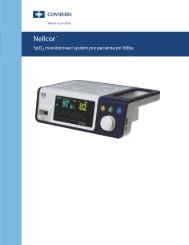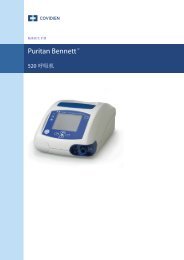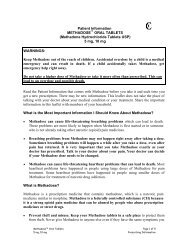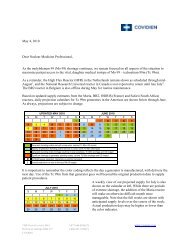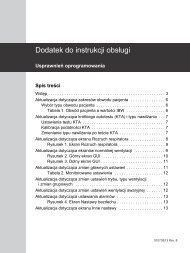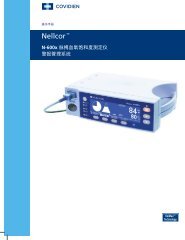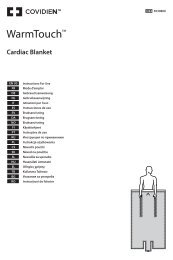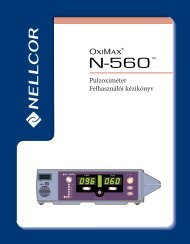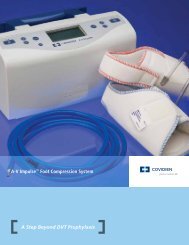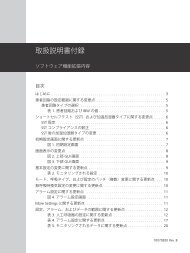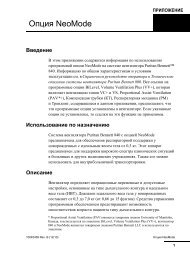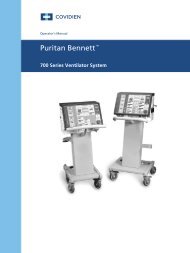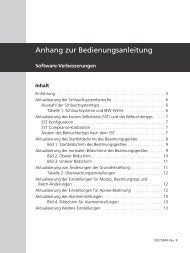IFU for 840softwareenhancementsaddendumenglish - Covidien
IFU for 840softwareenhancementsaddendumenglish - Covidien
IFU for 840softwareenhancementsaddendumenglish - Covidien
You also want an ePaper? Increase the reach of your titles
YUMPU automatically turns print PDFs into web optimized ePapers that Google loves.
Operator’s Manual Addendum<br />
Software Enhancements<br />
Table of Contents<br />
Introduction . . . . . . . . . . . . . . . . . . . . . . . . . . . . . . . . . . . . . . . . . . . . . . 1<br />
Update to patient circuit ranges . . . . . . . . . . . . . . . . . . . . . . . . . . . . . . . 4<br />
Patient circuit type selection . . . . . . . . . . . . . . . . . . . . . . . . . . . . . . . . 4<br />
Table 1. Patient circuit and IBW values . . . . . . . . . . . . . . . . . . . . . 4<br />
Update to short self test (SST) and humidification type . . . . . . . . . . . . . . 5<br />
SST setup . . . . . . . . . . . . . . . . . . . . . . . . . . . . . . . . . . . . . . . . . . . . . . 5<br />
SST compliance calibration . . . . . . . . . . . . . . . . . . . . . . . . . . . . . . . . . 5<br />
Changing humidification type after SST . . . . . . . . . . . . . . . . . . . . . . . 5<br />
Update to Ventilator Startup screen . . . . . . . . . . . . . . . . . . . . . . . . . . . . 6<br />
Figure 1. Ventilator Startup screen . . . . . . . . . . . . . . . . . . . . . . . . 6<br />
Update to normal ventilation screens . . . . . . . . . . . . . . . . . . . . . . . . . . . 7<br />
Figure 2. Upper GUI screen . . . . . . . . . . . . . . . . . . . . . . . . . . . . . . 7<br />
Figure 3. Lower GUI screen . . . . . . . . . . . . . . . . . . . . . . . . . . . . . . 8<br />
Update to main settings changes . . . . . . . . . . . . . . . . . . . . . . . . . . . . . . 8<br />
Table 2. Monitored settings . . . . . . . . . . . . . . . . . . . . . . . . . . . . . 9<br />
Update to mode, breath type, and batch (multiple) settings changes . . . . 9<br />
Update to apnea ventilation settings changes . . . . . . . . . . . . . . . . . . . . . 9<br />
Update to setting alarms . . . . . . . . . . . . . . . . . . . . . . . . . . . . . . . . . . . . 10<br />
Figure 4. Alarm setup screen . . . . . . . . . . . . . . . . . . . . . . . . . . . . 10<br />
Update to More Settings . . . . . . . . . . . . . . . . . . . . . . . . . . . . . . . . . . . . 10<br />
Updated ranges <strong>for</strong> settings, alarms, and data . . . . . . . . . . . . . . . . . . . . 11<br />
Table 3. Ventilator settings updates . . . . . . . . . . . . . . . . . . . . . . 11<br />
Table 4. Alarm settings updates . . . . . . . . . . . . . . . . . . . . . . . . . 16<br />
Table 5. Patient data updates . . . . . . . . . . . . . . . . . . . . . . . . . . . 19<br />
10070808 Rev. C
Operator’s Manual Addendum<br />
Update to alarm silence . . . . . . . . . . . . . . . . . . . . . . . . . . . . . . . . . . . . 19<br />
Update to graphics . . . . . . . . . . . . . . . . . . . . . . . . . . . . . . . . . . . . . . . . 20<br />
Printing graphics . . . . . . . . . . . . . . . . . . . . . . . . . . . . . . . . . . . . . . . 20<br />
Flow volume (F-V) loop . . . . . . . . . . . . . . . . . . . . . . . . . . . . . . . . . . 21<br />
Figure 5. Flow-Volume loop . . . . . . . . . . . . . . . . . . . . . . . . . . . . 21<br />
Update to RS-232 port in<strong>for</strong>mation . . . . . . . . . . . . . . . . . . . . . . . . . . . 22<br />
Updated alarm summary . . . . . . . . . . . . . . . . . . . . . . . . . . . . . . . . . . . 23<br />
Table 6. Alarm summary updates . . . . . . . . . . . . . . . . . . . . . . . . 23<br />
Ventilation Type – INVASIVE/NIV . . . . . . . . . . . . . . . . . . . . . . . . . . . . . . 26<br />
Intended Use . . . . . . . . . . . . . . . . . . . . . . . . . . . . . . . . . . . . . . . . . . 26<br />
Breathing Interfaces . . . . . . . . . . . . . . . . . . . . . . . . . . . . . . . . . . . . 27<br />
Changes to ventilator GUI screens . . . . . . . . . . . . . . . . . . . . . . . . . . 27<br />
Figure 6. New patient set up screen – NIV . . . . . . . . . . . . . . . . . 28<br />
Figure 7. New patient ventilator settings screen – NIV . . . . . . . . 29<br />
Figure 8. More patient data screen – NIV . . . . . . . . . . . . . . . . . . 29<br />
Table 7. Visual differences between NIV and INVASIVE<br />
Vent Types . . . . . . . . . . . . . . . . . . . . . . . . . . . . . . . . . . . . . . . . . 30<br />
NIV setup . . . . . . . . . . . . . . . . . . . . . . . . . . . . . . . . . . . . . . . . . . . . 31<br />
High Spontaneous Inspiratory Time limit setting . . . . . . . . . . . . . . . 33<br />
Apnea setup . . . . . . . . . . . . . . . . . . . . . . . . . . . . . . . . . . . . . . . . . . 33<br />
Alarm setup . . . . . . . . . . . . . . . . . . . . . . . . . . . . . . . . . . . . . . . . . . 34<br />
Figure 9. New patient alarm settings . . . . . . . . . . . . . . . . . . . . . 34<br />
Changing patient from INVASIVE to NIV Vent Type . . . . . . . . . . . . . 35<br />
Table 8. Automatic settings changes – INVASIVE to NIV . . . . . . . 35<br />
Changing patient from NIV to INVASIVE Vent Type . . . . . . . . . . . . . 36<br />
Table 9. Automatic settings changes – NIV to INVASIVE . . . . . . . 36<br />
Update to RS-232 commands . . . . . . . . . . . . . . . . . . . . . . . . . . . . . . . . 37<br />
SNDF command . . . . . . . . . . . . . . . . . . . . . . . . . . . . . . . . . . . . . . . 37<br />
Table 10. SNDF response . . . . . . . . . . . . . . . . . . . . . . . . . . . . . . 38<br />
SNDA command . . . . . . . . . . . . . . . . . . . . . . . . . . . . . . . . . . . . . . . 45<br />
Table 11. Updated MISCA response . . . . . . . . . . . . . . . . . . . . . . 45<br />
ii 10070808 Rev. C Software Enhancements
Introduction<br />
Operator’s Manual Addendum<br />
This addendum describes enhancements to the 840 Ventilator System and changes<br />
to the 840 Ventilator System Operator’s and Technical Reference Manual part<br />
number 4-075609-00 up to and including Revision G, and part number 4-070088-<br />
00 up to and including Revision F.<br />
NOTE:<br />
If you have 840 Ventilator System Operator’s and Technical Reference Manual<br />
part number 4-075609-00 Revision F, your manual has been updated with the<br />
in<strong>for</strong>mation contained in this addendum except <strong>for</strong> any references to PAV*+<br />
option, PA breath type, the Flow-Volume loop plot in<strong>for</strong>mation starting on<br />
page 21, and the RS-232 command update starting on page 37. If your manual<br />
is Revision G, it has been updated with the in<strong>for</strong>mation contained in this<br />
addendum except <strong>for</strong> the Flow-Volume loop plot in<strong>for</strong>mation starting on<br />
page 21 and the RS-232 command update starting on page 37.<br />
If you have 840 Ventilator System Operator’s and Technical Reference Manual<br />
part number 4-070088-00 Revision E or later, your manual has been updated<br />
with the in<strong>for</strong>mation contained in this addendum except <strong>for</strong> the Flow-Volume<br />
loop plot in<strong>for</strong>mation starting on page 21 and the RS-232 command update<br />
starting on page 37.<br />
Updates to the manual include:<br />
• The patient circuit type specified during short self test (SST) determines default<br />
settings and available ranges <strong>for</strong> ventilator operation.<br />
• Certain recommended ranges can be overridden. Touching the OK button<br />
allows operation outside the recommended setting range.<br />
• The humidification type can be changed after running SST without adversely<br />
affecting breath delivery or spirometry, and humidifier volume can be entered<br />
<strong>for</strong> non-HME humidifiers during or following SST.<br />
• A prompt has been added at the start of the SST compliance test to allow the<br />
operator to check <strong>for</strong> the presence of water in the humidifier.<br />
• A reminder arrow now flashes at the Ventilator Startup screen to prompt the<br />
operator to consider previous settings.<br />
• Display of data on the upper GUI screen is larger <strong>for</strong> improved visibility at a<br />
distance.<br />
Software Enhancements 10070808 Rev. C 1
Operator’s Manual Addendum<br />
• Alarm Silence in Progress and 100% O2 /CAL in Progress indicators (when<br />
active) and the CANCEL buttons <strong>for</strong> them are displayed on the lower GUI<br />
screen.<br />
• The main settings (buttons displayed at the top of the lower screen) can be set<br />
individually or in a batch to allow quick setup.<br />
• Drop-down menus of available selections have been added <strong>for</strong> mode,<br />
mandatory type, spontaneous type, trigger type, apnea mandatory type, and<br />
graphics plot setup.<br />
• The lower screen displays monitored settings if you select or change the settings<br />
that affect them:<br />
� Selecting or changing the volume setting displays the current volume per<br />
weight ratio (VT/IBW or VT SUPP/IBW).<br />
� Selecting or changing the respiratory rate or volume setting displays the set<br />
minute volume (VE SET).<br />
• Expiratory sensitivity (ESENS) is now a primary setting that appears at the top of<br />
the lower screen. ESENS can be set as high as 80% <strong>for</strong> leak management.<br />
• The alarm setting bars on the Alarm Setup screen display the recent range of<br />
the corresponding patient data.<br />
• Circuit disconnect and patient data alarms no longer reset an active alarm<br />
silence.<br />
• Oxygen sensor calibration (100% O2 CAL) can be canceled.<br />
• An automatic expiratory or inspiratory pause maneuver can be canceled by<br />
touching the CANCEL button on the lower GUI display.<br />
• If the ventilator enters idle mode or an occlusion status cycling (OSC) state<br />
when NeoMode is active, the ventilator delivers 40% O2 if available.<br />
• Peak Circuit Pressure (PPEAK) shows the peak inspiratory pressure, and is<br />
updated at the end of each inspiration. Previously, this number represented the<br />
peak pressure <strong>for</strong> the whole breath.<br />
• Mean Circuit Pressure (PMEAN) indicates the average circuit pressure over all<br />
breaths <strong>for</strong> the previous 1-minute interval.<br />
• The O2 sensor alarm is no longer a DEVICE ALERT alarm.<br />
• Various alarm parameters have been changed to reduce the occurrence of<br />
nuisance alarms.<br />
2 10070808 Rev. C Software Enhancements
• The following have changed:<br />
PMEAN PPEAK P<br />
%<br />
This symbol is now defined as Rise Time Percent<br />
(was Flow Acceleration). The symbol has not changed.<br />
New symbol <strong>for</strong> mean airway pressure (was PCIRC). New symbol <strong>for</strong> peak circuit pressure (monitored)<br />
(was PCIRC MAX).<br />
PEEP New symbol <strong>for</strong> end expiratory pressure (monitored)<br />
(was PE END).<br />
VE SET New symbol, now defined as set minute volume<br />
(was V and defined as minute volume).<br />
CSTAT New symbol <strong>for</strong> static compliance (was C).<br />
RSTAT New symbol <strong>for</strong> static resistance (was R).<br />
Operator’s Manual Addendum<br />
• The extended self test (EST) compressor leak test now takes approximately one<br />
minute (was five minutes).<br />
• Several spontaneous data parameters (rapid shallow breathing index,<br />
spontaneous inspiratory time, and spontaneous percent inspiratory time) have<br />
been added to the More Patient Data screen.<br />
• Graphics displays have been enhanced to show estimated carinal or lung<br />
pressure when the respective TC or PA spontaneous breath type is active.<br />
• Frozen graphics can now be printed.<br />
• Available wave<strong>for</strong>m plots now include a Flow-Volume loop.<br />
• The clinician must now select a Ventilation Type, either INVASIVE or NIV (Noninvasive<br />
Ventilation), during new patient set-up.<br />
• The INSPIRATION TOO LONG alarm now applies only to INVASIVE Vent Type,<br />
and a High Spontaneous Inspiratory Time Limit (2TI SPONT) ventilator setting is<br />
available <strong>for</strong> NIV Vent Type with SIMV and SPONT breath modes.<br />
• A new RS-232 command, SNDF, has been added.<br />
Software Enhancements 10070808 Rev. C 3
Operator’s Manual Addendum<br />
Update to patient circuit ranges<br />
This section updates Operator’s Manual section 2.3.<br />
Warning<br />
When using a Fisher & Paykel* humidifier with the 840 Ventilator, use the<br />
Fisher & Paykel* model 210 or 250 humidifier chamber <strong>for</strong> adult patients and<br />
the model 220 or 290 humidifier chamber <strong>for</strong> pediatric patients. Other<br />
Fisher & Paykel* humidifier chambers can cause water to splash into the<br />
patient circuit during circuit disconnects and high peak flow rate conditions.<br />
Patient circuit type selection<br />
Table 1 shows IBW values and patient circuit types. The “Allowed but not<br />
recommended” ranges require an override.<br />
Table 1. Patient circuit and IBW values<br />
Recommendation Ideal body weight (IBW) in kg (lb)<br />
Recommended Neonatal: 0.5-7.0 kg (1.1-15 lb)<br />
Pediatric: 7.0-24 kg (15-53 lb)<br />
Adult: 25-150 kg (55-330 lb)<br />
Allowed but not Neonatal: Not applicable.<br />
recommended Pediatric: 3.5-6.5 kg (7.7-14.3 lb), and 25-35 kg (55-77 lb)<br />
Adult: 7-24 kg (15-53 lb)<br />
Warning<br />
Recommended ranges exist to ensure patient safety. Only those with expertise to judge<br />
the appropriate circumstances should override the recommended ranges.<br />
4 10070808 Rev. C Software Enhancements
Update to short self test (SST) and humidification type<br />
This section updates Operator’s Manual sections 3 and 4.8.<br />
SST setup<br />
Operator’s Manual Addendum<br />
For optimum inspiratory volume and spirometry accuracy, SST asks you to specify<br />
the humidification type: Heated exp tube, Non-heated exp tube, or HME<br />
(HME = heat-moisture exchanger). For non-HME humidifiers, you can touch the<br />
HUMIDIFIER VOLUME button, then turn the knob to select the dry humidifier<br />
volume (the humidifier’s specified volume, not compressible volume). The<br />
HUMIDIFIER VOLUME button is not visible when HME is selected.<br />
SST compliance calibration<br />
For a humidification type of Heated exp tube or Non-heated exp tube, the<br />
ventilator prompts you to indicate if there is water (YES or NO) in the humidifier.<br />
Changing humidification type after SST<br />
For optimum spirometry accuracy, humidification type and volume (<strong>for</strong> non-HME<br />
humidifiers) can now be changed after running SST.<br />
Follow these steps to select the humidification type and set its volume:<br />
1. Touch the OTHER SCREENS button, then touch the MORE SETTINGS<br />
button.<br />
2. Touch the HUMIDIFICATION TYPE button, then turn the knob to select the<br />
new value (Heated exp tube, Non-heated exp tube, or HME).<br />
3. For non-HME humidifiers, touch the HUMIDIFIER VOLUME button, then turn<br />
the knob to select the dry humidifier volume. (The HUMIDIFIER VOLUME<br />
button is not visible when HME is selected.)<br />
4. Review the proposed settings, then press ACCEPT to apply the new settings.<br />
Software Enhancements 10070808 Rev. C 5
Operator’s Manual Addendum<br />
Update to Ventilator Startup screen<br />
This section updates Operator’s Manual section 4.1. The Ventilator Startup screen<br />
(Figure 1 below) has changed:<br />
• Expiratory sensitivity (ESENS) is now a primary setting and appears at the top of<br />
the lower GUI screen.<br />
• The startup screen includes flashing reminder arrow (next to the SAME<br />
PATIENT button) that prompts the user to consider previous settings.<br />
• During and after Ventilator Startup, drop-down menus of available selections<br />
are displayed <strong>for</strong> vent type, mode, mandatory type, spontaneous type, trigger<br />
type, and apnea mandatory type.<br />
• Once Ventilator Startup is complete, the volume per weight ratio is displayed<br />
when the volume setting is selected or changed. Volume = tidal volume (VT) when breath type is VC, target volume (VT) when breath type is VC+, target<br />
support volume (VT SUPP) when breath type is VS.<br />
• VE is no longer displayed in the Ventilator Startup screen.<br />
• For additional changes to Ventilator Startup screen, see “Ventilation Type –<br />
INVASIVE/NIV” on page 26.<br />
Figure 1. Ventilator Startup screen<br />
6 10070808 Rev. C Software Enhancements
Update to normal ventilation screens<br />
Operator’s Manual Addendum<br />
This section updates Operator’s Manual section 4.2.<br />
The upper GUI screen (Figure 2 below) now displays patient data in large characters<br />
on a single line <strong>for</strong> improved distance visibility. Breath type is indicated in the upper<br />
left corner (C = control, S = spontaneous, A = assist).<br />
To view units and symbol definitions at the bottom of the screen, touch the<br />
displayed symbol. Additional data is available on the More Data screen.<br />
For additional changes to normal ventilation screens see “Ventilation Type –<br />
INVASIVE/NIV” on page 26.<br />
Figure 2. Upper GUI screen<br />
The lower GUI screen (Figure 3) shows the Alarm Silence In Progress and the 100%<br />
O2/CAL In Progress indicators if no higher-priority display is active. The lower screen<br />
automatically displays the In Progress indicators when you press the 100% O 2 /<br />
CAL 2 min key.<br />
Software Enhancements 10070808 Rev. C 7
Operator’s Manual Addendum<br />
Figure 3. Lower GUI screen<br />
Update to main settings changes<br />
This section updates Operator’s Manual section 4.3 to reflect that main settings can<br />
now be changed in a batch to allow quick setup. Main settings are the buttons<br />
displayed at the top of the lower screen. Follow these steps to change main<br />
settings:<br />
1. Touch a setting you want to change. Turn the knob to set the desired value.<br />
2. Repeat <strong>for</strong> each setting to be changed.<br />
3. Touch CANCEL ALL to cancel the new input and leave the settings unchanged.<br />
4. Touch ACCEPT to apply the new setting(s).<br />
8 10070808 Rev. C Software Enhancements
Operator’s Manual Addendum<br />
The lower screen displays monitored settings (Table 2) if you select or change the<br />
settings that affect them:<br />
V E SET<br />
V T/IBW<br />
V T SUPP/IBW<br />
Table 2. Monitored settings<br />
Set minute volume: displayed along with the breath timing bar<br />
whenever you select or change the respiratory rate (f) or volume setting.<br />
Volume per weight ratio: displayed when you select or change the tidal<br />
volume (V T, when breath type is VC) or target volume (V T, when breath<br />
type is VC+) setting.<br />
Volume per weight ratio: displayed when you select or change the<br />
target support volume (V T SUPP , when breath type is VS) setting.<br />
Update to mode, breath type, and batch (multiple) settings<br />
changes<br />
This section updates Operator’s Manual section 4.4 to reflect that V E is no longer<br />
displayed in the Current Vent Setup screen.<br />
Update to apnea ventilation settings changes<br />
This section updates Operator’s Manual section 4.6 to reflect that when the apnea<br />
mandatory type is selected in the Apnea Setup screen, a drop-down menu of all<br />
available selections is displayed with the current selection highlighted. Apnea set<br />
minute volume is no longer displayed in the Apnea Setup screen.<br />
Software Enhancements 10070808 Rev. C 9
Operator’s Manual Addendum<br />
Update to setting alarms<br />
This section updates Operator’s Manual section 4.7 to reflect the updated Alarm<br />
Setup screen (Figure 4). Alarm setting bars now include a highlighted block that<br />
represents the recent range of the corresponding patient data.<br />
Update to More Settings<br />
Figure 4. Alarm setup screen<br />
This section updates Operator’s Manual section 4.8. The More Settings screen has<br />
changed:<br />
• ESENS has been removed (and is now a primary setting).<br />
• Humidifier Volume (<strong>for</strong> non-HME humidifiers) has been added.<br />
The procedure <strong>for</strong> changing any setting on the More Settings screen is the same.<br />
10 10070808 Rev. C Software Enhancements
Updated ranges <strong>for</strong> settings, alarms, and data<br />
Operator’s Manual Addendum<br />
This section updates Operator’s Manual section 4.9 and Appendix A.6, and includes<br />
only changes to ventilator settings or alarms. Ventilators equipped with the<br />
NeoMode option can select all ranges (neonatal, pediatric, or adult). Only pediatric<br />
and adult ranges are available to ventilators without the NeoMode option.<br />
Some settings have recommended limits that can be overridden. When a proposed<br />
setting exceeds the recommended limits, the ventilator sounds a tone and asks you<br />
to confirm that you want to override the recommended range.<br />
Table 3 lists changes to ventilator settings. Table 4 lists changes to alarm settings.<br />
Table 5 lists additions to patient data.<br />
Table 3. Ventilator settings updates<br />
Setting Function/Details<br />
Apnea mandatory<br />
type<br />
Apnea interval<br />
(TA )<br />
Apnea respiratory<br />
rate (f)<br />
Expiratory sensitivity<br />
(E SENS )<br />
New patient value:<br />
Neonatal: Same as non-apnea mandatory type when non-apnea<br />
mandatory type is PC or VC. PC when non-apnea mandatory<br />
type is VC+.<br />
Pediatric: Same as non-apnea mandatory type when non-apnea<br />
mandatory type is PC or VC. VC when non-apnea mandatory<br />
type is VC+.<br />
Adult: Same as non-apnea mandatory type when non-apnea<br />
mandatory type is PC or VC. VC when non-apnea mandatory<br />
type is VC+.<br />
New patient value:<br />
Neonatal: 10 s<br />
Pediatric: 15 s<br />
Adult: 20 s<br />
New patient value:<br />
Neonatal: 20/min<br />
Pediatric: 14/min<br />
Adult: 10/min<br />
Range: 1% to 80%; 1 to 10 L/min <strong>for</strong> PAV*+ option<br />
New patient value: 25%; 3 L/min <strong>for</strong> PAV*+ option<br />
Software Enhancements 10070808 Rev. C 11
Operator’s Manual Addendum<br />
Flow pattern Range:<br />
Flow pattern not selectable when mandatory type is PC or VC+.<br />
New patient value:<br />
Neonatal: Descending ramp<br />
Pediatric: Square<br />
Adult: Square<br />
Flow sensitivity<br />
(V SENS)<br />
High spontaneous<br />
inspiratory time limit<br />
(2TI SPONT)<br />
(Available when Vent<br />
Type is NIV, only)<br />
Table 3. Ventilator settings updates (continued)<br />
Setting Function/Details<br />
Range:<br />
Neonatal: 0.1 L/min to 10 L/min<br />
Pediatric/Adult: 0.2 L/min to 20 L/min<br />
New patient value:<br />
Neonatal: 1.0 L/min<br />
Pediatric: 2.0 L/min<br />
Adult: 3.0 L/min<br />
Range:<br />
Neonatal: 0.4 sec to (1 + (0.1 x IBW)) sec<br />
Pediatric/Adult: 0.4 sec to (1.99 + (0.02 x IBW)) sec<br />
New patient value:<br />
Neonatal: (1 + (0.1 x IBW)) sec<br />
Pediatric/Adult: (1.99 + (0.02 x IBW)) sec<br />
Humidifier volume Function: The empty volume of the currently-installed humidifier.<br />
Range: 100 mL to 1000 mL<br />
Default: 480 mL<br />
Resolution: 10 mL<br />
12 10070808 Rev. C Software Enhancements
Ideal body weight<br />
(IBW)<br />
Table 3. Ventilator settings updates (continued)<br />
Setting Function/Details<br />
Range:<br />
Neonatal: � 0.5 kg (1.1 lb), � 7.0 kg (15 lb)<br />
Pediatric: � 3.5 kg (7.7 lb), � 35 kg (77 lb)<br />
Adult: � 7.0 kg (15 lb), � 150 kg (330 lb)<br />
New patient value:<br />
Neonatal: 3.0 kg<br />
Pediatric: 15.0 kg<br />
Adult: 50 kg<br />
Resolution:<br />
0.1 kg <strong>for</strong> 0.5 kg to 3.5 kg<br />
0.5 kg <strong>for</strong> 3.5 kg to 10 kg<br />
1.0 kg <strong>for</strong> 10 kg to 50 kg<br />
5 kg <strong>for</strong> 50 kg to 100 kg<br />
10 kg <strong>for</strong> 100 kg to 150 kg<br />
Operator’s Manual Addendum<br />
Inspiratory time (TI ) New patient value: Based on circuit type, IBW, and VC settings<br />
Resolution: 0.01 s when mandatory type is PC or VC+, 0.02 s when<br />
mandatory type is VC.<br />
Mandatory type Function: Sets the type of mandatory breath: volume control (VC),<br />
pressure control (PC), or volume control plus (VC+). VC+ is only<br />
available with the Volume Ventilation Plus option when the mode<br />
is A/C or SIMV.<br />
Range: VC, PC, or VC+<br />
New patient value:<br />
Neonatal: PC<br />
Pediatric/Adult: VC<br />
Mode New patient value:<br />
Neonatal: SIMV<br />
Pediatric/Adult: A/C<br />
O 2 % New patient value:<br />
Neonatal: 40%<br />
Pediatric/Adult: 100%<br />
Patient circuit type Range: Neonatal, Pediatric, or Adult. Neonatal is only available with<br />
the NeoMode option.<br />
Software Enhancements 10070808 Rev. C 13
Operator’s Manual Addendum<br />
Peak flow<br />
(V MAX)<br />
Respiratory rate<br />
(f)<br />
Table 3. Ventilator settings updates (continued)<br />
Setting Function/Details<br />
Range:<br />
Neonatal: ��1.0 L/min, ��30 L/min<br />
Pediatric: ��3.0 L/min, ��60 L/min<br />
Adult: ��3.0 L/min, ��150 L/min<br />
New patient value: Based on IBW<br />
Resolution:<br />
0.1 L/min <strong>for</strong> flows of 1 L/min to 20 L/min<br />
1 L/min <strong>for</strong> flows of 20 L/min and above<br />
Function: Sets the minimum number of mandatory breaths the<br />
patient receives per minute. Active in A/C, SIMV, and BiLevel.<br />
Range:<br />
Neonatal: 1.0 /min to 150 /min<br />
Pediatric/Adult: 1.0 /min to 100 /min<br />
New patient value:<br />
Neonatal: 20 /min<br />
Pediatric: 14 /min<br />
Adult: 10/min<br />
Resolution:<br />
0.1/min <strong>for</strong> 1.0 /min to 10 /min<br />
1/min <strong>for</strong> 10 /min to 150 /min<br />
Accuracy: ± 0.1 (+0.6% of setting) 1 /min averaged over 60 s or<br />
5 breaths, whichever occurs last.<br />
Spontaneous type Function: Sets the type of spontaneous breath: pressure supported<br />
(PS), not pressure supported (NONE), Tube Compensated (TC),<br />
volume support (VS), or proportional assist (PA).<br />
TC is only available with the TC option when the patient circuit type<br />
is pediatric or adult. VS is only available with the Volume Ventilation<br />
Plus option when the mode is SPONT.<br />
PA is only available with the PAV*+ option when the IBW<br />
� 25.0 kg (patient type is Adult), tube I.D. � 6.0 mm, and the mode<br />
is SPONT<br />
Range:<br />
Neonatal: PS, NONE, VS<br />
Pediatric: PS, NONE, TC, VS<br />
Adult: PS, NONE, TC, VS, PA<br />
14 10070808 Rev. C Software Enhancements
Target volume (V T ) or<br />
Tidal volume (V T)<br />
Table 3. Ventilator settings updates (continued)<br />
Setting Function/Details<br />
Operator’s Manual Addendum<br />
Range:<br />
Neonatal: 5 mL to 315 mL<br />
Pediatric/Adult: 25 mL to 2500 mL<br />
(IBW-based range is 1.16 � IBW minimum; 45.7 � IBW<br />
maximum)<br />
New patient value:<br />
Neonatal: The greater of 5 mL or (7.25 � IBW)<br />
Pediatric/Adult: The greater of 25 mL or (7.25 � IBW)<br />
Resolution:<br />
1 mL <strong>for</strong> 5 mL to 100 mL<br />
5 mL <strong>for</strong> 100 mL to 400 mL<br />
10 mL <strong>for</strong> 400 mL to 2500 mL<br />
Trigger type Range:<br />
Neonatal: Flow (V -TRIG)<br />
Pediatric/Adult: Pressure (P-TRIG) or V -TRIG<br />
New patient value: V -TRIG<br />
Vent type Range:<br />
INVASIVE or NIV (non-invasive)<br />
New patient value: INVASIVE<br />
Software Enhancements 10070808 Rev. C 15
Operator’s Manual Addendum<br />
Table 4. Alarm settings updates<br />
Alarm Range<br />
High circuit pressure<br />
(2PPEAK) High exhaled minute<br />
volume<br />
(2VE TOT)<br />
High exhaled tidal<br />
volume limit<br />
(2VTE) High respiratory rate<br />
(2f TOT )<br />
New patient value:<br />
Neonatal: 30 cmH 2O<br />
Pediatric/Adult: 40 cmH 2 O<br />
Range:<br />
OFF or<br />
��0.10 L/min or > low exhaled minute volume limit<br />
and<br />
Neonatal: ��10 L/min<br />
Pediatric: ��30 L/min<br />
Adult: ��100 L/min<br />
New patient value: Based on IBW<br />
Range:<br />
OFF or<br />
> low exhaled spontaneous tidal volume limit<br />
> low exhaled mandatory tidal volume limit<br />
and<br />
Neonatal: 5 mL to 500 mL<br />
Pediatric: 25 mL to 1500 mL<br />
Adult: 25 mL to 3000 mL<br />
New patient value: Based on IBW<br />
Resolution:<br />
1 mL <strong>for</strong> 5 mL to 100 mL<br />
5 mL <strong>for</strong> 100 mL to 400 mL<br />
10 mL <strong>for</strong> 400 mL to 3000 mL<br />
Range:<br />
OFF or<br />
Neonatal: 10 /min to 170 /min<br />
Pediatric/Adult: 10 /min to 110 /min<br />
New patient value: OFF<br />
Resolution: 1 /min<br />
16 10070808 Rev. C Software Enhancements
Low exhaled<br />
mandatory tidal<br />
volume<br />
(4V TE MAND )<br />
Low exhaled minute<br />
volume<br />
(4V E TOT)<br />
Table 4. Alarm settings updates (continued)<br />
Alarm Range<br />
Range:<br />
OFF or<br />
����mL<br />
< high exhaled tidal volume limit<br />
and<br />
Neonatal: ��300 mL<br />
Pediatric: ��1000 mL<br />
Adult: ��2500 mL<br />
New patient value (INVASIVE Vent Type): Based on IBW<br />
New patient value (NIV Vent Type): OFF<br />
Resolution:<br />
1 mL <strong>for</strong> 1 mL to 100 mL<br />
5 mL <strong>for</strong> 100 mL to 400 mL<br />
10 mL <strong>for</strong> 400 mL to 2500 mL<br />
Range:<br />
OFF or<br />
< high exhaled minute volume limit, and<br />
Neonatal: OFF or 0.01 L/min to 10 L/min<br />
Pediatric: 0.05 L/min to 30 L/min<br />
Adult: 0.05 L/min to 60 L/min<br />
New patient value (INVASIVE Vent Type): Based on IBW<br />
New patient value (NIV Vent Type): OFF<br />
Resolution:<br />
0.005 L/min <strong>for</strong> 0.01 L/min to 0.50 L/min<br />
0.05 L/min <strong>for</strong> 0.05 L/min to 5.0 L/min<br />
0.5 L/min <strong>for</strong> 5.0 L/min to 60.0 L/min<br />
Operator’s Manual Addendum<br />
Software Enhancements 10070808 Rev. C 17
Operator’s Manual Addendum<br />
Low exhaled<br />
spontaneous tidal<br />
volume<br />
(4V TE SPONT )<br />
Low circuit pressure<br />
(4P PEAK)<br />
Table 4. Alarm settings updates (continued)<br />
Alarm Range<br />
Range:<br />
OFF or<br />
��1 mL<br />
< high exhaled tidal volume limit<br />
and<br />
Neonatal: ��300 mL<br />
Pediatric: ��1000 mL<br />
Adult: ��2500 mL<br />
New patient value (INVASIVE Vent Type): Based on IBW<br />
New patient value (NIV Vent Type): OFF<br />
Resolution:<br />
1 mL <strong>for</strong> 1 mL to 100 mL<br />
5 mL <strong>for</strong> 100 mL to 400 mL<br />
10 mL <strong>for</strong> 400 mL to 2500 mL<br />
Available only during NIV or when VC+ is selected as Mandatory Type<br />
during INVASIVE ventilation.<br />
Range:<br />
NIV: OFF to 2PPEAK -1 cmH2O VC+: PEEP to 2PPEAK -1 cmH2O NOTE:<br />
When VC+ is selected, 4P PEAK can be set to OFF if PEEP is set<br />
to 0.<br />
New patient value: PEEP + 6 cmH2O Resolution:<br />
0.5 cmH2O <strong>for</strong> pressures < 20 cmH2O 1 cmH2O <strong>for</strong> pressures � 20 cmH2O 18 10070808 Rev. C Software Enhancements
Update to alarm silence<br />
Table 5. Patient data updates<br />
Data Range<br />
Rapid shallow<br />
breathing index<br />
(f/VT) Spontaneous<br />
inspiratory time<br />
(T I SPONT )<br />
Spontaneous<br />
percent inspiratory<br />
time<br />
(TI /TTOT )<br />
Operator’s Manual Addendum<br />
Function: Displays the ratio of respiratory rate to inspired volume<br />
measurements on the More Patient Data screen. Available <strong>for</strong><br />
spontaneous breaths only. Accessible during normal ventilation<br />
by pressing the More Patient Data button on the upper GUI<br />
screen.<br />
Range: 0.0 1/min-L to 600 1/min-L<br />
Resolution:<br />
0.1 <strong>for</strong> f/VT < 10 1/min-L<br />
1 <strong>for</strong> f/VT � 10 1/min-L<br />
Function: Displays the measured patient inspiratory time on the<br />
More Patient Data screen. Available <strong>for</strong> spontaneous breaths<br />
only. Accessible during normal ventilation by pressing the<br />
More Patient Data button on the upper GUI screen.<br />
Range: 0.00 s to 10.00 s<br />
Resolution: 0.01 s<br />
Function: Displays the ratio of the inspiratory time to total breath<br />
cycle time measurements on the More Patient Data screen.<br />
Available <strong>for</strong> spontaneous breaths only. Accessible during normal<br />
ventilation by pressing the More Patient Data button on the<br />
upper GUI screen.<br />
Range: 0.00 to 0.80<br />
Resolution: 0.01<br />
This section updates Operator’s Manual section 5.1.<br />
• Patient data and patient circuit disconnect alarms do not cancel an alarm<br />
silence. Other high-urgency alarms still cancel an alarm silence.<br />
• Alarm Silence in Progress indicator: if no higher-priority screens are displayed on<br />
the lower GUI screen, a bar graph representing the alarm silence period<br />
appears.<br />
Software Enhancements 10070808 Rev. C 19
Operator’s Manual Addendum<br />
Update to graphics<br />
This section updates Operator’s Manual section 6 to reflect these enhancements to<br />
graphics displays:<br />
• The PLOT 1 and PLOT 2 buttons now display drop-down menus of available<br />
selections with the current selection highlighted.<br />
• If a pressure-time wave<strong>for</strong>m is selected and the spontaneous type is TC or PA, a<br />
new SHADOW TRACE button is displayed. The SHADOW TRACE button<br />
allows you to enable or disable the graphic display of carinal pressure or lung<br />
pressure when TC or PA is active.<br />
• The pressure-time curve now shows an estimate of carinal pressure (PCARI) or<br />
lung pressure (PLUNG) as a shaded area within the wave<strong>for</strong>m when the<br />
spontaneous breath type is TC or PA, respectively.<br />
NOTE:<br />
The graphic display of carinal or lung pressure is an estimate, not an actual<br />
measurement.<br />
Printing graphics<br />
Frozen graphics can now be printed. When graphics are frozen on the screen and<br />
the selected device <strong>for</strong> RS-232 serial port 1 is a printer, a PRINT button now<br />
appears in the upper left corner of the screen. Follow these steps to print frozen<br />
graphics:<br />
1. Touch the PRINT button. The flashing message PRINTING replaces the PLOT<br />
SETUP, UNFREEZE, and PRINT buttons. You may stop printing by touching<br />
the CANCEL button.<br />
2. Once all graphics data has been sent to the printer, the PLOT SETUP,<br />
UNFREEZE, and PRINT buttons reappear.<br />
NOTE:<br />
To print graphics, RS-232 serial port 1 must be configured with PRINTER as the<br />
selected device.<br />
20 10070808 Rev. C Software Enhancements
Flow volume (F-V) loop<br />
Operator’s Manual Addendum<br />
A Flow-Volume loop is available <strong>for</strong> use with or without the Respiratory Mechanics<br />
option (Figure 5).<br />
Scaling is selectable by the user, from -2000 to 6000 mL <strong>for</strong> volume (x-axis), and up<br />
to 200 L/min <strong>for</strong> flow (y-axis). The plot begins at the start of inspiration with the<br />
inspiratory flow curve plotted above the x-axis, and the expiratory flow curve<br />
plotted below the x-axis.<br />
NOTE:<br />
Traditionally, Flow-Volume loops are presented with inspired flow plotted below<br />
the horizontal axis, and exhaled flow plotted above, with the plot beginning at<br />
the start of exhalation.<br />
Figure 5. Flow-Volume loop<br />
Software Enhancements 10070808 Rev. C 21
Operator’s Manual Addendum<br />
Update to RS-232 port in<strong>for</strong>mation<br />
This section updates Operator’s Manual section E.2 to reflect that the RS-232 port<br />
can now be configured to select the attached device, baud rate, data bits, and<br />
parity. Follow these steps to configure the RS-232 port:<br />
1. From the Ventilator Settings screen, press the MORE SCREENS button.<br />
2. Press the COMMUNICATIONS SETUP button.<br />
3. Touch the serial port 1 button, then turn the knob to select the attached<br />
device (DCI or PRINTER). Choose DCI if the attached device is an external<br />
host/monitor, or PRINTER <strong>for</strong> a printer. (Only Port 1 may be configured as a<br />
printer port.)<br />
4. Touch the BAUD RATE button, then turn the knob to select the baud rate<br />
(1200, 2400, 4800, 9600, 19200, or 38400).<br />
5. Touch the DATA BITS button, and turn the knob to select either 7 or 8 data<br />
bits.<br />
6. Touch the PARITY MODE button, then turn the knob to select parity (None,<br />
Even, or Odd). Even or Odd parity may only be selected if the number of data<br />
bits is set to 7.<br />
7. Press ACCEPT to apply these changes.<br />
22 10070808 Rev. C Software Enhancements
Updated alarm summary<br />
Operator’s Manual Addendum<br />
This section updates Technical Reference Manual section 13.1.2. Table 6 lists<br />
changes to the alarm summary.<br />
Base<br />
message<br />
Urgency<br />
Table 6. Alarm summary updates<br />
Analysis<br />
message<br />
APNEA Medium Apnea ventilation.<br />
Breath interval ><br />
apnea interval.<br />
INSPIRATION<br />
TOO LONG<br />
High Extended apnea<br />
duration or<br />
multiple apnea<br />
events.<br />
Low Last 2 spont<br />
breaths = IBW<br />
based T I limit.<br />
Medium Last 4 spont<br />
breaths = IBW<br />
based TI limit.<br />
High Last 10 or<br />
more spont<br />
breaths = IBW<br />
based TI limit.<br />
O2 SENSOR Low Ventilation<br />
unaffected.<br />
Remedy<br />
message<br />
Comments<br />
Unchanged. Unchanged.<br />
Unchanged. INSPIRATION TOO<br />
LONG alarm only<br />
functions when Vent<br />
Type is INVASIVE.<br />
O 2 sensor out<br />
of calibration/<br />
failure. Press<br />
100% O 2<br />
CAL, replace<br />
or disable.<br />
Background checks<br />
have detected a<br />
problem. Resets when<br />
operator successfully<br />
calibrates oxygen<br />
sensor, or disables<br />
oxygen sensor.<br />
Software Enhancements 10070808 Rev. C 23
Operator’s Manual Addendum<br />
Base<br />
message<br />
Table 6. Alarm summary updates (continued)<br />
Urgency<br />
Analysis<br />
message<br />
1P PEAK Low Last breath � set<br />
limit.<br />
Medium Last 3 breaths<br />
� set limit.<br />
High Last 4 or more<br />
breaths � set limit.<br />
1VTE Low Last 2 breaths<br />
� set limit.<br />
Medium Last 4 breaths<br />
� set limit.<br />
High Last 10 or more<br />
breaths<br />
� set limit.<br />
1VE TOT Low VE TOT � set limit.t<br />
<strong>for</strong> � 30s.<br />
Medium VE TOT � set limit<br />
<strong>for</strong> > 30s.<br />
High VE TOT � set limit<br />
<strong>for</strong> > 120s.<br />
1f TOT Low f TOT � set limit <strong>for</strong><br />
� 30s.<br />
Medium fTOT � set limit <strong>for</strong><br />
> 30s.<br />
High fTOT � set limit <strong>for</strong><br />
> 120s.<br />
Remedy<br />
message<br />
Check patient<br />
circuit & ET<br />
tube.<br />
Measured airway<br />
pressure � set limit.<br />
Ventilator truncates<br />
current breath unless<br />
already in exhalation.<br />
Possible dependent<br />
alarms:<br />
3VTE MAND<br />
3V E TOT<br />
1f TOT<br />
Comments<br />
Unchanged. Unchanged.<br />
Unchanged. Unchanged.<br />
Unchanged. Unchanged.<br />
24 10070808 Rev. C Software Enhancements
Base<br />
message<br />
Table 6. Alarm summary updates (continued)<br />
Urgency<br />
Analysis<br />
message<br />
3 VTE MAND Low Last 2 mand<br />
breaths<br />
� set limit.<br />
Medium Last 4 mand<br />
breaths � set limit.<br />
High Last 10 or more<br />
mand breaths<br />
� set limit.<br />
3VTE SPONT Low Last 2 spont<br />
breaths � set limit.<br />
Medium Last 4 spont<br />
breaths<br />
� set limit.<br />
High Last 10 or more<br />
spont breaths<br />
� set limit.<br />
3VE TOT Low VE TOT � set limit<br />
<strong>for</strong> � 30s.<br />
Medium VE TOT� � set limit<br />
<strong>for</strong> > 30s.<br />
High VE TOT � set limit<br />
<strong>for</strong> > 120s.<br />
3PPEAK Low Last 2 breaths,<br />
pressure � set<br />
limit.<br />
Medium Last 4 breaths,<br />
pressure � set<br />
limit.<br />
High Last 10 or more<br />
breaths, pressure<br />
� set limit.<br />
Remedy<br />
message<br />
Operator’s Manual Addendum<br />
Unchanged. Unchanged.<br />
Unchanged. Unchanged.<br />
Unchanged. Unchanged.<br />
Check <strong>for</strong><br />
leaks.<br />
Comments<br />
Peak inspiratory<br />
pressure ��set limit.<br />
(Available only when<br />
Vent Type is NIV or<br />
during INVASIVE<br />
ventilation when<br />
Mandatory Type is<br />
VC+.)<br />
Software Enhancements 10070808 Rev. C 25
Operator’s Manual Addendum<br />
Ventilation Type – INVASIVE/NIV<br />
This section updates Operator’s Manual Section 4. The clinician must now select<br />
either INVASIVE or NIV (non-invasive ventilation) using the VENT TYPE button that<br />
appears on the New Patient Setup or Current Setup screens.<br />
Choosing INVASIVE allows conventional ventilation with either endotracheal or<br />
tracheostomy tubes. During invasive ventilation, the 840 ventilator operates in the<br />
same way as the previous software version with no changes to the appearance of<br />
the main ventilator screens.<br />
When VC+ is selected <strong>for</strong> Mandatory Type during New Patient Setup or when<br />
changing the current setup, a Low Circuit Pressure alarm (3PPEAK) is now available<br />
that replaces the previously non-settable Low Inspiratory Pressure alarm. Refer to<br />
Table 4 and Table 6 <strong>for</strong> more in<strong>for</strong>mation on the 3PPEAK alarm.<br />
Warning<br />
Because the VC+ pressure control algorithm does not allow the target<br />
inspiratory pressure to fall below PEEP + 5 cmH 2O, setting the 4P PEAK alarm limit<br />
at or below this level, in effect, disables the alarm.<br />
Choosing NIV allows ventilation with various non-invasive interfaces and with<br />
uncuffed endotracheal tubes in NeoMode. NIV improves the 840 ventilator’s ability<br />
to handle large system leaks associated with these interfaces by providing pressurebased<br />
disconnect alarms, minimizing false disconnect alarms, and replacing the<br />
INSPIRATION TOO LONG alarm with a High Spontaneous Inspiratory Time limit<br />
(2TI SPONT) setting and visual indicator.<br />
The remaining Ventilation Type discussion focuses on the changes associated with<br />
the addition of NIV.<br />
Intended Use<br />
NIV is intended <strong>for</strong> use by neonate, pediatric, and adult patients possessing<br />
adequate neural-ventilatory coupling and stable, sustainable, respiratory drive.<br />
26 10070808 Rev. C Software Enhancements
Breathing Interfaces<br />
Operator’s Manual Addendum<br />
<strong>Covidien</strong> has successfully tested the following non-vented interfaces with NIV:<br />
Full-face Mask: Puritan Bennett Benefit Non-vented Full Face Mask (large, part<br />
number 4-005253-00), ResMed Mirage* Non-vented Full Face Mask (medium)<br />
Nasal Mask: ResMed Mirage* Non-vented Mask (medium)<br />
Infant Nasal Prongs: Sherwood Davis & Geck Argyle CPAP Nasal Cannula (small),<br />
Hudson RCI*, Infant Nasal CPAP System (No. 3)<br />
Uncuffed neonatal ET tube: Mallinckrodt Uncuffed Tracheal Tube, Murphy<br />
(3.0 mm)<br />
Warning<br />
• Use only non-vented patient interfaces with NIV.<br />
• Full-faced masks used <strong>for</strong> non-invasive ventilation should provide visibility<br />
of the patient's nose and mouth to reduce the risk of emesis aspiration.<br />
• Do not ventilate patients intubated with cuffed endotracheal or<br />
tracheostomy tubes using NIV Vent Type.<br />
Changes to ventilator GUI screens<br />
The following changes have been introduced to the GUI touch screens that allow<br />
the clinician to set up the ventilator and readily identify that it is operating using<br />
NIV:<br />
• VENT TYPE button added to the New Patient and Current Setup screens to<br />
select either INVASIVE or NIV ventilation types.<br />
• Breath modes and breath type choices are limited to a subset of the settings<br />
available in INVASIVE ventilation.<br />
• A new ventilator setting, High Spontaneous Inspiratory Time Limit (2TI SPONT), is<br />
available when either SIMV or SPONT breath mode is selected.<br />
• Indicators <strong>for</strong> NIV appear on both upper and lower GUI screens. Figure 6 and<br />
Figure 7 show the lower GUI screen during New Patient Setup <strong>for</strong> NIV.<br />
• A new alarm setting, Low Circuit Pressure (4PPEAK), is available.<br />
Software Enhancements 10070808 Rev. C 27
Operator’s Manual Addendum<br />
1<br />
2<br />
3<br />
4<br />
1. Vent Type Button: New button used to select between INVASIVE or<br />
NIV.<br />
2. Breath Mode: Only A/C, SIMV, and SPONT modes are allowed with<br />
NIV.<br />
3. Mandatory Type: Only VC and PC are available with NIV.<br />
4. Spontaneous Type: Only PS or NONE are available with NIV when<br />
SIMV or SPONT breath mode is selected.<br />
5. Trigger Type: Only Flow Triggering is available with NIV.<br />
Figure 6. New patient set up screen – NIV<br />
28 10070808 Rev. C Software Enhancements<br />
5
“N” in header<br />
indicates NIV<br />
Vent Type.<br />
2T I SPONT<br />
setting button.<br />
Note D SENS<br />
defaults to<br />
OFF.<br />
During NIV, V TI<br />
appears in Vital<br />
patient data area.<br />
NIV and 1T I SPONT<br />
indicators on More<br />
patient data<br />
subscreen. Hidden if<br />
two or more alarms<br />
present.<br />
PEEP moved to<br />
More patient data<br />
subscreen during<br />
NIV.<br />
Figure 7. New patient ventilator settings screen – NIV<br />
Figure 8. More patient data screen – NIV<br />
Operator’s Manual Addendum<br />
Software Enhancements 10070808 Rev. C 29
Operator’s Manual Addendum<br />
Table 7 summarizes the differences in upper and lower GUI screens between NIV<br />
and INVASIVE ventilation types.<br />
Table 7. Visual differences between NIV and INVASIVE Vent Types<br />
Display NIV INVASIVE Comments<br />
Upper GUI:<br />
Vital patient<br />
data area (top of<br />
upper GUI<br />
screen)<br />
Upper GUI:<br />
More Patient<br />
Data subscreen<br />
Upper GUI:<br />
Alarm area<br />
Lower GUI:<br />
Upper left of<br />
settings area<br />
PPEAK, PMEAN, VTI, I:E, fTOT , VTE ,<br />
VE TOT<br />
Displays current PEEP<br />
value in addition to<br />
same data displayed<br />
in INVASIVE Vent<br />
Type.<br />
NIV and 1T I SPONT (if<br />
set limit is reached)<br />
displayed in yellow<br />
letters.<br />
N A/C<br />
N SIMV<br />
N SPONT<br />
displayed as black<br />
letters in yellow<br />
highlight<br />
PPEAK, PMEAN, PEEP, I:E, fTOT , VTE ,<br />
VE TOT<br />
Data displayed<br />
according to selected<br />
breath mode.<br />
When Vent Type is<br />
NIV, PEEP is displayed<br />
on More Patient Data<br />
subscreen.<br />
Patient data varies<br />
according to selected<br />
breath mode.<br />
N/A If 2 alarms are<br />
simultaneously active,<br />
“NIV” and “1T I SPONT”<br />
are hidden from view<br />
until one alarm is no<br />
longer active.<br />
Breath mode<br />
displayed in white<br />
letters.<br />
Indicator <strong>for</strong> NIV<br />
always present on<br />
lower GUI screen<br />
regardless of alarm<br />
conditions.<br />
30 10070808 Rev. C Software Enhancements
Lower GUI:<br />
New Patient and<br />
Current Setup<br />
screens<br />
NIV setup<br />
“N” appears in New<br />
Patient and Current<br />
Setup header.<br />
DSENS button available<br />
during patient setup.<br />
New patient value set<br />
to OFF.<br />
After settings have<br />
been accepted, DSENS can also be accessed<br />
in the same manner as<br />
<strong>for</strong> INVASIVE.<br />
D SENS button only<br />
accessed by touching<br />
OTHER SCREENS and<br />
MORE SETTINGS<br />
buttons. New patient<br />
value set to 75%.<br />
Operator’s Manual Addendum<br />
Table 7. Visual differences between NIV and INVASIVE Vent Types (continued)<br />
Display NIV INVASIVE Comments<br />
Lower GUI:<br />
Ventilator<br />
settings<br />
Lower GUI:<br />
Alarm settings<br />
2T I SPONT setting<br />
available<br />
4P PEAK alarm setting<br />
available<br />
NIV can be initiated from either the New Patient Setup screen during Vent start-up<br />
or while the patient is being ventilated invasively. Refer to the sections “Changing<br />
patient from INVASIVE to NIV Vent Type” on page 35 and “Changing patient from<br />
NIV to INVASIVE Vent Type” on page 36 <strong>for</strong> in<strong>for</strong>mation on automatic settings<br />
changes that occur when switching between Vent Types.<br />
Software Enhancements 10070808 Rev. C 31<br />
N/A<br />
N/A 2T I SPONT setting<br />
available only in SIMV<br />
or SPONT modes<br />
during NIV.<br />
4P PEAK alarm setting<br />
available only with<br />
VC+ selected as<br />
Mandatory Type.<br />
4P PEAK setting replaces<br />
Low Insp Pressure<br />
alarm (previously not<br />
settable) in VC+.
Operator’s Manual Addendum<br />
Follow these steps to set up the ventilator <strong>for</strong> NIV:<br />
To set up a new patient:<br />
To set up a patient currently being<br />
ventilated:<br />
1. Turn the ventilator on. 1. Press the VENT SETUP button. Proceed<br />
to step 4.<br />
2. Select NEW PATIENT.<br />
3. Enter the patient’s Ideal Body Weight<br />
(IBW) and press CONTINUE.<br />
4. Touch the VENT TYPE button and turn the rotary knob to change to NIV.<br />
5. Touch the MODE button and turn the knob to select AC, SIMV, or SPONT. (BILEVEL<br />
mode is not available with NIV).<br />
6. Touch the MANDATORY TYPE button and turn the knob to choose pressure control<br />
(PC) or volume control (VC). (VC+ is not available with NIV.)<br />
7. If either SIMV or SPONT was selected in step 5, touch the SPONTANEOUS TYPE<br />
button and turn the knob to select PS or NONE. (TC and VS are not available with NIV.)<br />
NOTE:<br />
With NIV selected as Vent Type, the only allowable trigger type is flow triggering<br />
(V -TRIG).<br />
8. Press CONTINUE and adjust settings as needed. See the section, "High Spontaneous<br />
Inspiratory Time limit setting," below, <strong>for</strong> in<strong>for</strong>mation on this ventilator setting.<br />
NOTE:<br />
With NIV selected as Vent Type, the DISCONNECT SENSITIVITY (D SENS ) button appears<br />
on the Settings screen set to OFF. If desired, touch the button and turn the knob to set<br />
a value. To change the disconnect sensitivity after you have applied the ventilator<br />
settings, touch the OTHER SCREENS button, then the MORE SETTINGS button and<br />
make your changes.<br />
9. Press ACCEPT to apply the settings. Review the apnea and alarm settings as described<br />
below.<br />
32 10070808 Rev. C Software Enhancements
High Spontaneous Inspiratory Time limit setting<br />
Operator’s Manual Addendum<br />
NIV includes a setting in SIMV or SPONT modes <strong>for</strong> High Spontaneous Inspiratory<br />
Time limit (2T I SPONT). When a patient’s inspiratory time reaches or exceeds the set<br />
limit, the ventilator transitions from inspiration to exhalation, and the 1T I SPONT<br />
symbol appears on the upper GUI screen, indicating that the ventilator has<br />
truncated the breath (see Figure 8).<br />
Warning<br />
No audible alarm sounds in conjunction with the visual 1TI SPONT indicator, nor<br />
does the indicator appear in any alarm log or alarm message.<br />
The 1TI SPONT indicator appears at the beginning of a ventilator-initiated exhalation<br />
and remains visible <strong>for</strong> as long as the ventilator truncates breaths in response to the<br />
2TI SPONT setting. The 1TI SPONT indicator disappears when the patient’s inspiratory<br />
time returns to less than the 2TI SPONT setting, or after 15 seconds has elapsed after<br />
the beginning of exhalation of the last truncated breath.<br />
It is possible that the target inspiratory pressure may not be reached if the 2TI SPONT<br />
setting is not long enough, or if system leaks are so large as to cause the ventilator<br />
to truncate the breath at the maximum allowable 2TI SPONT setting.<br />
NOTE:<br />
To reduce the potential <strong>for</strong> not reaching the target pressure, minimize the leaks<br />
in the system and increase the Rise time % and/or decrease the E SENS setting, if<br />
appropriate.<br />
Apnea setup<br />
Set the patient’s apnea parameters as usual. NIV does not change the way that<br />
apnea parameters are set.<br />
Software Enhancements 10070808 Rev. C 33
Operator’s Manual Addendum<br />
Alarm setup<br />
Touch the ALARM SETUP button to display the current alarm settings and change<br />
the alarm settings as needed. A low circuit pressure (3P PEAK) alarm is now available<br />
during NIV to detect potential circuit disconnects or large system leaks based upon<br />
pressure measurements in the patient circuit. Refer to Table 4 and Table 6 <strong>for</strong> more<br />
in<strong>for</strong>mation regarding this alarm. The 3P PEAK alarm may be turned OFF, if desired.<br />
Figure 9 shows the NIV alarm screen with new patient default settings.<br />
NIV<br />
indicator<br />
4P PEAK<br />
alarm limit<br />
Figure 9. New patient alarm settings<br />
34 10070808 Rev. C Software Enhancements
Warning<br />
Operator’s Manual Addendum<br />
With NIV selected as the Vent Type, the new patient value <strong>for</strong> each of the<br />
following alarm limits is OFF:<br />
2f TOT 4V E TOT 4V TE MAND 4V TE SPONT<br />
Additionally, the 4PPEAK alarm can be set to OFF.<br />
Ensure that you have set these alarms appropriately be<strong>for</strong>e connecting the<br />
patient to the ventilator.<br />
Changing patient from INVASIVE to NIV Vent Type<br />
Some ventilator settings available during INVASIVE ventilation are not available<br />
during NIV. Table 8 shows the settings changes that occur automatically when<br />
changing the Vent Type from INVASIVE to NIV on the same patient.<br />
Table 8. Automatic settings changes – INVASIVE to NIV<br />
Current INVASIVE setting New NIV setting<br />
Breath Mode: BILEVEL Breath mode: A/C<br />
Breath Mode: SIMV or SPONT High TI SPONT (2TI SPONT) limit setting<br />
available<br />
Mandatory Type: VC+ Mandatory type:<br />
Adult/pediatric: VC<br />
Neonatal: PC<br />
Spontaneous Type: Any type except NONE<br />
or PS<br />
Spontaneous type: PS<br />
If Spontaneous Type set to NONE or PS<br />
during INVASIVE ventilation, NIV<br />
Spontaneous Type does not change.<br />
NOTE:<br />
In any delivered spontaneous breath, either INVASIVE or NIV, if Pressure Support is set<br />
to NONE or 0, there is always a target inspiratory pressure of 1.5 cmH2O applied.<br />
Software Enhancements 10070808 Rev. C 35
Operator’s Manual Addendum<br />
Trigger type: Pressure Trigger type: Flow<br />
(Flow triggering is only allowable trigger<br />
type in NIV)<br />
Alarm settings: 4P PEAK (if applicable),<br />
4V ETOT, 4V TE MAND, 4V TE SPONT, INSPIRATION<br />
TOO LONG (alarm limit based on IBW)<br />
D SENS<br />
Changing patient from NIV to INVASIVE Vent Type<br />
Alarm settings: 4PPEAK , 4VE TOT , 4VTE MAND ,<br />
4VTE SPONT default to NIV new patient values<br />
(see Table 4). INSPIRATION TOO LONG alarm<br />
not available.<br />
DSENS setting defaults to OFF.<br />
Table 9 shows automatic settings changes that occur when changing the same<br />
patient from NIV to INVASIVE Vent Type.<br />
Table 9. Automatic settings changes – NIV to INVASIVE<br />
Current NIV setting New INVASIVE setting<br />
Ventilator settings: 2TI SPONT<br />
Alarm settings: 4PPEAK , 4VE TOT , 4VTE MAND ,<br />
4VTE SPONT<br />
D SENS<br />
Table 8. Automatic settings changes – INVASIVE to NIV (continued)<br />
Current INVASIVE setting New NIV setting<br />
Warning<br />
When changing the Vent Type on the same patient, review the automatic<br />
settings changes described in Tables 8 and 9 and adjust appropriately.<br />
36 10070808 Rev. C Software Enhancements<br />
N/A<br />
Alarm settings: Default to new patient<br />
values dependent upon selected INVASIVE<br />
ventilator settings. INSPIRATION TOO LONG<br />
alarm becomes available.<br />
DSENS setting defaults to INVASIVE new<br />
patient value.
Update to RS-232 commands<br />
SNDF command<br />
Operator’s Manual Addendum<br />
This section updates Chapter 19 in the Technical Reference section of the 840<br />
Ventilator Operator’s and Technical Reference Manual.<br />
SNDF is a command sent from an external host device to the 840 ventilator<br />
instructing it to transmit all ventilator settings data, monitored patient data, and<br />
alarm settings and occurrences.<br />
Enter the SNDF command exactly as shown:<br />
SNDF<br />
When the ventilator receives the command SNDF, it responds with the code<br />
MISCF, followed by ventilator settings, monitored data, and alarm in<strong>for</strong>mation.<br />
The MISCF response follows this <strong>for</strong>mat:<br />
MISCF 1253173 FIELD 5,.., FIELD 173, <br />
Terminating carriage return<br />
End of transmission (03 hex)<br />
Data field, left-justified and padded with spaces<br />
Start of transmission (02 hex)<br />
Number of data fields between and <br />
Number of bytes between and <br />
Response code to SNDF command<br />
Software Enhancements 10070808 Rev. C 37
Operator’s Manual Addendum<br />
Table 10 lists the SNDF message components and their descriptions.<br />
NOTE:<br />
Non-applicable fields will either contain zero or be blank.<br />
Table 10. SNDF response<br />
Component Description<br />
MISCF Response to SNDF command (5 characters)<br />
1253 Number of bytes between and (4 characters)<br />
173 Number of fields between and (3 characters)<br />
Start of transmission character (02 hex)<br />
Field 5 Ventilator time (HH:MM_) (6 characters)<br />
Field 6 Ventilator ID to allow external hosts to uniquely identify each 840<br />
ventilator (18 characters)<br />
Field 7 Date (MMM_DD_YYYY_) (12 characters)<br />
Field 8 Vent Type (NIV______ or INVASIVE_) (9 characters)<br />
Field 9 Mode (A/C___, SIMV__, SPONT_ or BILEVL) (6 characters)<br />
Field 10 Mandatory Type (PC____, VC____, VC+___)<br />
(6 characters)<br />
Field 11 Spontaneous Type (NONE__, PS____, TC____, VS____, PA____)<br />
(6 characters)<br />
Field 12 Trigger Type setting (V-Trig or P-Trig) (6 characters)<br />
Field 13 Respiratory rate setting in bpm (6 characters)<br />
Field 14 Tidal volume setting in L (6 characters)<br />
Field 15 Peak flow setting in L/min (6 characters)<br />
Field 16 O2 % setting (6 characters)<br />
Field 17 Pressure sensitivity setting in cmH2O (6 characters)<br />
Field 18 PEEP/CPAP in cmH2O (6 characters)<br />
Field 19 Plateau setting in seconds (6 characters)<br />
Field 20 Apnea interval setting in seconds (6 characters)<br />
Field 21 Apnea tidal volume setting in L (6 characters)<br />
38 10070808 Rev. C Software Enhancements
Table 10. SNDF response (continued)<br />
Component Description<br />
Operator’s Manual Addendum<br />
Field 22 Apnea respiratory rate setting in bpm (6 characters)<br />
Field 23 Apnea peak flow setting in L/min (6 characters)<br />
Field 24 Apnea O2 % setting (6 characters)<br />
Field 25 PCV apnea inspiratory pressure setting in cmH2O (6 characters)<br />
Field 26 PCV Apnea Inspiratory Time setting in seconds (6 characters)<br />
Field 27 Apnea flow pattern setting (SQUARE or RAMP) (6 characters)<br />
Field 28 Apnea mandatory type setting (PC or VC) (6 characters)<br />
Field 29 Inspiratory component of Apnea I:E ratio (if apnea mandatory type is<br />
PC) (6 characters)<br />
Field 30 Expiratory component of Apnea I:E ratio (if apnea mandatory type is PC)<br />
(6 characters)<br />
Field 31 Support pressure setting (cmH2O) Field 32 Flow pattern setting (SQUARE or RAMP) (6 characters)<br />
Field 33 100% O2 Suction (ON or OFF) (6 characters)<br />
Field 34 High inspiratory pressure alarm setting (2PPEAK) in cmH2O (6 characters)<br />
Field 35 Low inspiratory pressure alarm setting (4PPEAK ) in cmH2O or OFF<br />
(6 characters)<br />
Field 36 High exhaled minute volume (2VE TOT ) alarm setting in L/min or OFF<br />
(6 characters)<br />
Field 37 Low exhaled minute volume (4VE TOT ) alarm setting in L/min or OFF<br />
(6 characters)<br />
Field 38 High exhaled mandatory tidal volume (2VTE MAND ) alarm setting in mL<br />
or OFF (6 characters)<br />
Field 39 Low exhaled mandatory tidal volume (4VTE MAND ) alarm setting in mL or<br />
OFF (6 characters)<br />
Field 40 High exhaled spontaneous tidal volume (2VTE SPONT ) alarm setting in mL<br />
or OFF (6 characters)<br />
Field 41 Low exhaled spontaneous tidal volume (4VTE SPONT ) alarm setting in mL<br />
or OFF (6 characters)<br />
Field 42 High respiratory rate (2fTOT ) alarm setting in bpm or OFF (6 characters)<br />
Field 43 High inspired tidal volume (2VTI ) alarm setting in mL (6 characters)<br />
Software Enhancements 10070808 Rev. C 39
Operator’s Manual Addendum<br />
Table 10. SNDF response (continued)<br />
Component Description<br />
Field 44 Base flow setting in L/min (6 characters)<br />
Field 45 Flow sensitivity setting in L/min (6 characters)<br />
Field 46 PCV inspiratory pressure (PI ) setting in cmH2O (6 characters)<br />
Field 47 PCV inspiratory time (TI) setting in seconds (6 characters)<br />
Field 48 Inspiratory component of I:E ratio setting or High component of H:L<br />
ratio setting (6 characters)<br />
Field 49 Expiratory component of I:E ratio setting or Low component of H:L ratio<br />
setting (6 characters)<br />
Field 50 Constant during rate change setting (I-time, I/E, or E-time) (6 characters)<br />
Field 51 Tube I.D. setting in mm (6 characters)<br />
Field 52 Tube type setting (ET or TRACH) (6 characters)<br />
Field 53 Humidification type setting (Non-Heated Exp, Heated Exp, or HME)<br />
(18 characters)<br />
Field 54 Humidifier volume setting in L (6 characters)<br />
Field 55 O2 sensor setting (Enabled or Disabled) (9 characters)<br />
Field 56 Disconnect sensitivity setting in % or OFF (6 characters)<br />
Field 57 Rise time % setting (6 characters)<br />
Field 58 PAV*+ percent support setting (6 characters)<br />
Field 59 Expiratory sensitivity (ESENS ) setting in % or L/min <strong>for</strong> PA breath type<br />
(6 characters)<br />
Field 60 IBW setting in kg (6 characters)<br />
Field 61 Target support volume (VT SUPP) setting in L (6 characters)<br />
Field 62 High PEEP (PEEPH ) setting in cmH2O (6 characters)<br />
Field 63 Low PEEP (PEEPL ) setting in cmH2O (6 characters)<br />
Field 64 High PEEP time (TH) setting in seconds (6 characters)<br />
Field 65 High spontaneous inspiratory time limit (2TI SPONT ) setting in seconds<br />
(6 characters)<br />
Field 66 Circuit type setting (ADULT, PEDIATRIC, or NEONATAL) (9 characters)<br />
Field 67 Low PEEP time (TL ) setting in seconds (6 characters)<br />
40 10070808 Rev. C Software Enhancements
Table 10. SNDF response (continued)<br />
Component Description<br />
Operator’s Manual Addendum<br />
Field 68 Expiratory time (TE) setting in seconds (6 characters)<br />
Field 69 End inspiratory pressure (PI END) in cmH2O (6 characters)<br />
Field 70 Respiratory rate (fTOT ) in bpm (6 characters)<br />
Field 71 Exhaled tidal volume (VTE) in L (6 characters)<br />
Field 72 Patient exhaled minute volume (VE TOT) in L/min (6 characters)<br />
Field 73 Peak airway pressure (PPEAK ) in cmH2O (6 characters)<br />
Field 74 Mean airway pressure (PMEAN) in cmH2O (6 characters)<br />
Field 75 Expiratory component of monitored value of I:E ratio, assuming<br />
inspiratory component of 1 (6 characters)<br />
Field 76 I:E ratio (6 characters)<br />
Field 77 Delivered O2% (6 characters)<br />
Field 78 Inspired tidal volume (VTI) in L (6 characters)<br />
Field 79 Intrinsic PEEP (PEEPI ) in cmH2O (6 characters)<br />
Field 80 Estimated total resistance (RTOT) in cmH2O/L/s (6 characters)<br />
Field 81 Estimated patient resistance (RPAV) in cmH2O/L/s (6 characters)<br />
Field 82 Estimated patient elastance (EPAV ) in cmH2O/L (6 characters)<br />
Field 83 Estimated patient compliance (CPAV ) in mL/cmH2O (6 characters)<br />
Field 84 Normalized rapid shallow breathing index (f/VT//kg) (6 characters)<br />
Field 85 Rapid shallow breathing index (f/VT ) (6 characters)<br />
Field 86 Spontaneous percent inspiratory time (TI /TTOT ) (6 characters)<br />
Field 87 Monitored PEEP in cmH2O (6 characters)<br />
Field 88 Spontaneous inspiratory time (TI SPONT ) in seconds (6 characters)<br />
Field 89 Exhaled spontaneous minute volume (VE SPONT ) in L/min (6 characters)<br />
Field 90 Intrinsic PEEP (PEEPI) from expiratory pause maneuver in cmH2O (6 characters)<br />
Field 91 Total PEEP (PEEPTOT ) from expiratory pause maneuver in cmH2O (6 characters)<br />
Field 92 Static compliance (CSTAT ) from inspiratory pause maneuver in<br />
mL/cmH2O (6 characters)<br />
Software Enhancements 10070808 Rev. C 41
Operator’s Manual Addendum<br />
Table 10. SNDF response (continued)<br />
Component Description<br />
Field 93 Static resistance (RSTAT) from inspiratory pause maneuver in cmH2O/L/s (6 characters)<br />
Field 94 Plateau pressure (PPL) from inspiratory pause maneuver in cmH2O (6 characters)<br />
Field 95 High spontaneous inspiratory time (ALERT_ or blank) (6 characters)<br />
Field 96 Dynamic compliance (CDYN ) in mL/cmH2O (6 characters)<br />
Field 97 Dynamic resistance (RDYN) in cmH2O/L/s (6 characters)<br />
Field 98 Peak spontaneous flow (PSF) in L/min (6 characters)<br />
Field 99 Peak expiratory flow (PEF) in L/min (6 characters)<br />
Field 100 End expiratory flow (EEF) in L/min (6 characters)<br />
Field 101 Reserved<br />
Field 102 Negative inspiratory <strong>for</strong>ce (NIF) in cmH2O (6 characters)<br />
Field 103 P0.1 pressure change in cmH2O (6 characters)<br />
Field 104 Vital capacity (VC) in L (6 characters)<br />
Field 105 Alarm Silence (ON or OFF) (6 characters)<br />
Field 106 Apnea ventilation alarm* (6 characters)<br />
Field 107 High exhaled minute volume alarm* (1VE TOT) (6 characters)<br />
Field 108 High exhaled tidal volume alarm* (1VTE ) (6 characters)<br />
Field 109 High O2 % alarm* (6 characters)<br />
Field 110 High inspiratory pressure alarm* (1PPEAK) (6 characters)<br />
Field 111 High ventilator pressure alarm* (1PVENT ) (6 characters)<br />
Field 112 High respiratory rate alarm* (1fTOT ) (6 characters)<br />
Field 113 AC power loss alarm* (6 characters)<br />
Field 114 Inoperative battery alarm* (6 characters)<br />
Field 115 Low battery alarm* (6 characters)<br />
Field 116 Loss of power alarm* (6 characters)<br />
Field 117 Low exhaled mandatory tidal volume alarm* (3VTE MAND ) (6 characters)<br />
* Possible responses are: NORMAL, LOW, MEDIUM, HIGH, or RESET.<br />
42 10070808 Rev. C Software Enhancements
Table 10. SNDF response (continued)<br />
Component Description<br />
Operator’s Manual Addendum<br />
Field 118 Low exhaled minute volume alarm* (3VE TOT) (6 characters)<br />
Field 119 Low exhaled spontaneous tidal volume (3VTE SPONT) alarm*<br />
(6 characters)<br />
Field 120 Low O2 % alarm* (6 characters)<br />
Field 121 Low air supply pressure alarm* (6 characters)<br />
Field 122 Low O2 supply pressure alarm* (6 characters)<br />
Field 123 Compressor inoperative alarm* (6 characters)<br />
Field 124 Disconnect alarm* (6 characters)<br />
Field 125 Severe occlusion alarm* (6 characters)<br />
Field 126 Inspiration too long alarm* (6 characters)<br />
Field 127 Procedure error* (6 characters)<br />
Field 128 Compliance limited tidal volume (VT) alarm* (6 characters)<br />
Field 129 High inspired spontaneous tidal volume* (1VTI SPONT ) alarm<br />
(6 characters)<br />
Field 130 High inspired mandatory tidal volume (1VTI MAND ) alarm* (6 characters)<br />
Field 131 High compensation limit (1PCOMP) alarm* (6 characters)<br />
Field 132 PAV* startup too long alarm* (6 characters)<br />
Field 133 PAV* R and C not assessed alarm* (6 characters)<br />
Field 134 Volume not delivered (VC+) alarm* (6 characters)<br />
Field 135 Volume not delivered (VS) alarm* (6 characters)<br />
Field 136 Low inspiratory pressure (3PPEAK ) alarm* (6 characters)<br />
Field 137 Technical malfunction A5* (6 characters)<br />
Field 138 Technical malfunction A10* (6 characters)<br />
Field 139 Technical malfunction A15* (6 characters)<br />
Field 140 Technical malfunction A20* (6 characters)<br />
Field 141 Technical malfunction A25* (6 characters)<br />
Field 142 Technical malfunction A30* (6 characters)<br />
* Possible responses are: NORMAL, LOW, MEDIUM, HIGH, or RESET.<br />
Software Enhancements 10070808 Rev. C 43
Operator’s Manual Addendum<br />
Table 10. SNDF response (continued)<br />
Component Description<br />
Field 143 Technical malfunction A35* (6 characters)<br />
Field 144 Technical malfunction A40* (6 characters)<br />
Field 145 Technical malfunction A45* (6 characters)<br />
Field 146 Technical malfunction A50* (6 characters)<br />
Field 147 Technical malfunction A55* (6 characters)<br />
Field 148 Technical malfunction A60* (6 characters)<br />
Field 149 Technical malfunction A65* (6 characters)<br />
Field 150 Technical malfunction A70* (6 characters)<br />
Field 151 Technical malfunction A75* (6 characters)<br />
Field 152 Technical malfunction A80* (6 characters)<br />
Field 153 Technical malfunction A85* (6 characters)<br />
Field 154 Reserved<br />
Field 155 Reserved<br />
Field 156 Reserved<br />
Field 157 Reserved<br />
Field 158 Reserved<br />
Field 159 Reserved<br />
Field 160 Reserved<br />
Field 161 Reserved<br />
Field 162 Reserved<br />
Field 163 Reserved<br />
Field 164 Reserved<br />
Field 165 Reserved<br />
Field 166 Reserved<br />
Field 167 Reserved<br />
Field 168 Reserved<br />
Field 169 Reserved<br />
* Possible responses are: NORMAL, LOW, MEDIUM, HIGH, or RESET.<br />
44 10070808 Rev. C Software Enhancements
Field 170 Reserved<br />
Field 171 Reserved<br />
Field 172 Reserved<br />
Field 173 Reserved<br />
SNDA command<br />
Table 10. SNDF response (continued)<br />
Component Description<br />
Operator’s Manual Addendum<br />
When the SNDA command is sent to the 840 ventilator from an external host<br />
device, fields that were previously unused in the MISCA response now contain<br />
calculated values associated with Respiratory Mechanics. Refer to Chapter 19 of<br />
the Technical Reference portion of the 840 Ventilator Operator’s and Technical<br />
Reference Manual to see the complete MISCA response table. The following table<br />
lists the updated fields:<br />
Table 11. Updated MISCA response<br />
Component Description<br />
Field 63 Static compliance (CSTAT ) from inspiratory pause maneuver in<br />
mL/cmH2O (6 characters)<br />
Field 64 Static resistance (RSTAT ) from inspiratory pause maneuver in cmH2O/L/s (6 characters)<br />
Field 65 Dynamic compliance (CDYN ) in mL/cmH2O* (6 characters)<br />
Field 66 Dynamic resistance (RDYN ) in cmH2O/L/s* (6 characters)<br />
Field 67 Negative inspiratory <strong>for</strong>ce (NIF) in cmH2O* (6 characters)<br />
Field 68 Vital capacity (VC) in L* (6 characters)<br />
Field 69 Peak spontaneous flow (PSF) in L/min* (6 characters)<br />
* These fields will contain data only if the RM software option is installed.<br />
Software Enhancements 10070808 Rev. C 45
Operator’s Manual Addendum<br />
This page is intentionally blank.<br />
46 10070808 Rev. C Software Enhancements



